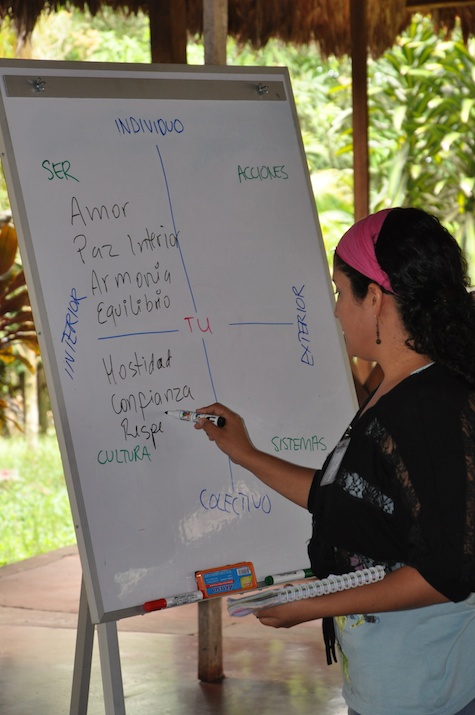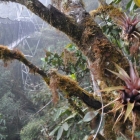Leading From Within The Private Sector
 One Sky - One Sky has been working in very difficult contexts around the world on issues of sustainability, environmental stewardship and community resilience. Since the year 2000 we have worked with dozens of organizations and placed over fifty individuals in remote locations. Places like war-torn Sierra Leone with child soldiers, the crisis ridden Niger Delta on energy issues or deep in the Amazon on rainforest conflicts. To work in these kinds of contexts we developed a personal leadership capacity development program. We also worked in Canada developing international capacity to tackle these kinds of challenges. Recognizing that capacity is one of the most serious obstacles toward improving our planet we started evolving our project work toward developing leadership in a variety of contexts. Recently we started working with the private sector because we recognized how quickly and powerfully enterprising leaders or teams of leaders in the private sector can make changes. Today we are working to expand our work on developing group leadership throughout supply chains that impact sustainability or community resilience. We have been privileged to work with well-known companies like COSTCO and Candor. So far, the results have been convincing with a more efficient bottom line, positive impacts in the community and better environmental stewardship.
One Sky - One Sky has been working in very difficult contexts around the world on issues of sustainability, environmental stewardship and community resilience. Since the year 2000 we have worked with dozens of organizations and placed over fifty individuals in remote locations. Places like war-torn Sierra Leone with child soldiers, the crisis ridden Niger Delta on energy issues or deep in the Amazon on rainforest conflicts. To work in these kinds of contexts we developed a personal leadership capacity development program. We also worked in Canada developing international capacity to tackle these kinds of challenges. Recognizing that capacity is one of the most serious obstacles toward improving our planet we started evolving our project work toward developing leadership in a variety of contexts. Recently we started working with the private sector because we recognized how quickly and powerfully enterprising leaders or teams of leaders in the private sector can make changes. Today we are working to expand our work on developing group leadership throughout supply chains that impact sustainability or community resilience. We have been privileged to work with well-known companies like COSTCO and Candor. So far, the results have been convincing with a more efficient bottom line, positive impacts in the community and better environmental stewardship.
Integral Theory - Key to our work is the use of integral theory and emergent design. Simply put, our experience in a variety of cultures and contexts convinces us that there are similar recognizable patterns of human behavior and that they are all developmental. They change over time in identifiable ways. Rather than tell people how to be a leader or what to do to change the world we simply use an integral toolkit to create fertile ground for this leadership to emerge on its own. Instrumental in this approach is the exploration of the self. Changes in the self inevitably result in changes on the ground. Changes in group identity can create explosive, positive results. While this sounds promising it is actually impossible to make promises about, because we start each program not knowing what the results will be. Emergent leadership is exactly that…it emerges into its own. The results, however, inevitably surprise everyone.
Each context for a leadership immersion is different. To date we have worked with groups of 20-30 individuals who volunteer their participation and are chosen based on being open minded and strategically placed. We have been using an application process or pre-selecting participants and we tend to choose pre-existing leaders. We don’t expect everyone to be leaders and we don’t work with people who don’t want to dive into the program fully. Our immersion courses have been extremely challenging and we don’t expect everyone to complete the program. If we start with 30 we are happy if 20 graduate. Our theory is that it does not take that many people to change a specific group context or solve a problem but they do need to have a strong unified vision, be committed and trust each other and they need to work hard. The nature of the curriculum is that participants are pushed, pulled and drawn of their own accord in this direction. This process is not always easy, and certainly not for everyone.
Leadership Intensives - The course is based on five intensive retreats over an eighteen-month period during which the participants commit to 3.5 days of intense work and introspection. Usually this starts on a Thursday evening and allows participants to get back to work on Monday. During the interim period of four months they are tasked with various initiatives and exercises. The intensives include individual coaching with trained integral coaches and a variety of specific skills training from conflict resolution to effective communication and project management. Normally the groups work in cohorts to hone their group skills. By far the most challenging component of what we do concerns individual personal development. We use various techniques to encourage each individual to explore their interior as well as the interior of their specific cultural or group context. This includes the use of voice dialogue with a trained practitioner. While this can result in a creative burst of energy the trick is to sustain these changes over enough time and with enough group support that the results stick. Eighteen months goes by quickly.
Our facilitators and coaches prefer to travel to the group and work as close to the context as possible. Because the intensives build consecutively, sharing meals and evening discussions is important. Participants attend them sequentially and remain present throughout each retreat. This is best accomplished by using a physical space that is close to where they live but far enough away that they cannot pop in and out of the sessions. Part of what we do involves exploring group dynamics and a physical retreat atmosphere promotes this.
Core Team - Our ideas are evolving and so is our team. So far, each leadership cohort group of up to thirty people has required two core facilitators and a dedicated local contact. Over the entire period of the course we will bring in, at a minimum, a certified integral coach and a voice dialogue practitioner. As we develop capacity ourselves, we intend to use each intensive to facilitate internships for emerging coaches and facilitators as well as invite local experts on key subjects. We are not experts on individual supply chain dynamics but there are experts out there. Each intensive will average three facilitators and presenters. At a minimum we need 15 participants and ideally between 24 and 30 to maximize resources.
Comments
Be the first to comment on this story. Use the form below.

